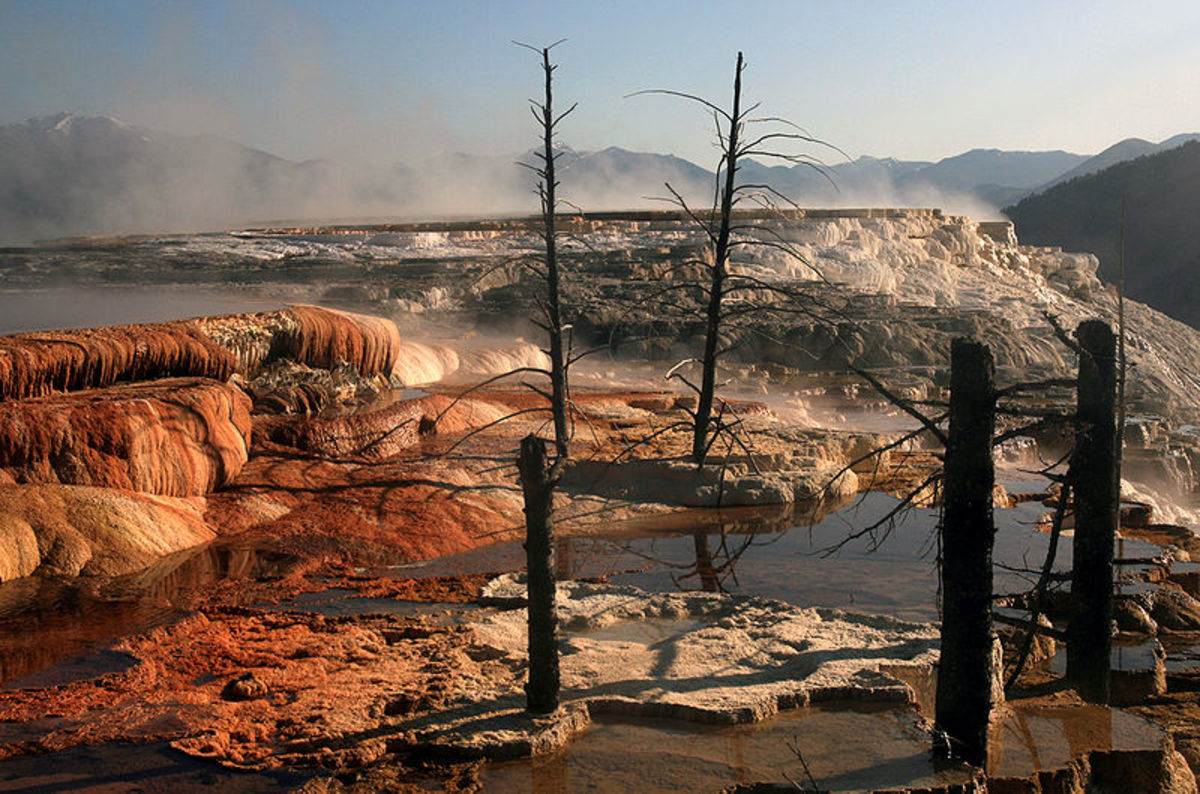Seismic Review and Forecast for November 2017
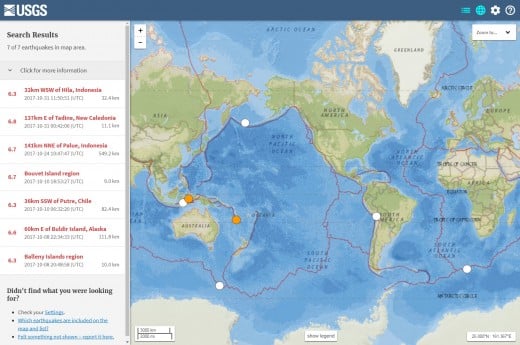
October was No Match for the Month Before
The earthquake frequency and energy released in October 2017 was similar to that of August, or two months earlier. Unlike September, which had earthquakes of 8.2 and 7.1 in magnitude, both August and October lacked any quakes of at least 6.8 in magnitude. However, in October, the earthquakes in the 6.3 to 6.7 magnitude range was about normal. Also, the number of fatalities in October was almost zero (there was only one fatality reported from a 6.1 magnitude event in Indonesia on the 31st of October), while there had been 471 deaths from the Mexican quakes of September (these figures originate from James Daniell's 2017 Earthquake Impact Database).
September had more and bigger surprises than October also. Near the beginning of September, a nuclear explosion was detected by seismologists that registered 6.3 on the moment magnitude scale, or the largest one that ever originated from North Korea. That surprise event was followed a few days later by the largest earthquake in Mexico in 85 years. That quake caused 100 deaths, but another one which occurred 11-12 days later and measuring 7.1 in magnitude was more inland and much closer to Mexico City, causing 367 deaths.
That last seismic event was on the anniversary of a magnitude 8 earthquake which killed at least 9.5 thousand deaths, mostly in Mexico City, in 1985. Although both of the two recent September temblors occurred in Mexico, without many days between them and of similar depth, seismologists did not recognize the second one as an aftershock of the first larger event due to the distance between their epicenters.
October's surprise was three earthquakes of 5.7-5.9 magnitude within three degrees of latitude of the North Pole. Since that area of the globe does not usually see much seismic activity, this was considered a rare series of events. Another near anomaly for October was that there were four earthquakes within a narrow range of magnitude of 6.6-6.7 magnitude. This is interesting to me because these quakes are just under the cut off that I use for forecasting seismic activity of significant size (determined by myself as of at least 6.8 in magnitude). In other words, my research has shown that the bigger the quake, the smaller the percentage of random events, or that more events can be correlated with astronomical or astrological factors. As a result of this apparent phenomena, there is a better than average chance, when using my methods, of a forecast being accurate for earthquakes of at least 6.8 magnitude and less than average chances for such sized earthquakes below that threshold.
In contrast with September's forecast, the one for October turned out to be less impressive. The reason for this I believe is that the percentage of randomness for that month approached 50%. November, on the other hand, with only 7 unlikely days for the occurrence of earthquakes of at least 6.8 magnitude, should have activity of at least average and more likely above that. In contrast to that 7 day period, there will be an opposing 8 day period where there will be, in my estimation, an 80% chance (give or take 15%) for there to be at least one quake of 6.8 magnitude. There is also 15 days out of the month where there is roughly a 50-50 chance of there being a second 6.8 magnitude event somewhere in the world.
Put another way, there will be 77% window days in November, which is similar to the 70% for the active September month, while there were only 55% window days in the not so active October month. There thus appears to be a trend indicating that there will be at least two seismic events of at least 6.8 magnitude in the month of November, 2017. Since two such sized quakes per month represents average activity, November, 2017, is likely to be an above average month.
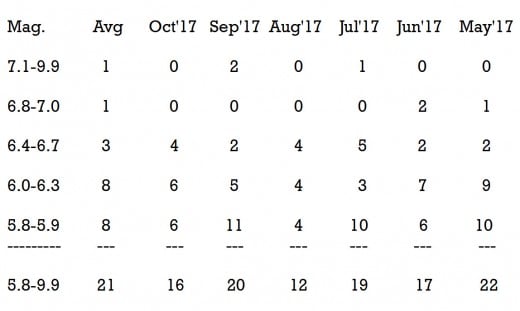
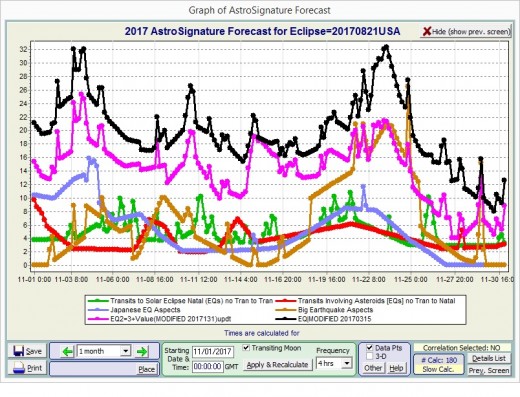
Getting Right Down to the Real Nitty Gritty
November also features a double underlined series of three dates, from the 22nd to the 24th of November, when it is estimated that the chances of such a significant seismic event will be close to 90%. There is also a stronger than usual likelihood that such an event will occur within the continental United States. The reason for that increased chance is due to the fact that the Sun will be approximately 90 degrees from where it and the Moon were located in the heavens at the time of the Great American Solar Eclipse of 22 August, 2017 (the shadow path of which passed through many potentially active seismic zones in the United States).
On the other hand, although the chances are higher for a significant seismic event to occur within the continental U.S. during those days, it won't increase to the point of the chances being greater than the chances outside of the U.S. At the same time, there could still be a significant event inside and another outside of the United States at that time. For any seismic event which may occur outside the U.S., the minimum magnitude would be 6.8 but, for inside the U.S. it would be as low as 6.4 magnitude.
Another reason why my forecast was not too impressive for October, was due to the fact that I had been updating my algorithm or menu of aspects used to foresee potential seismic windows, but the changes did not make it into the program I use to produce the graphs from which I determine my forecasts. If they had been up-to-date, there would have been a peak on the 10th of the month which would have made that date an open window instead of a closed one (there was a 6.3 and 6.7 magnitude quake on that date). Similarly, I wish to make a last minute change to the forecast for the 30th of November. I have that date crossed off in the calendar, but the last 8 hours of that day may come into play so I wish to here state that a significant event could occur during that time.
Here are the potential dates listed by their percentage of likelihood for the month of November 2017. This forecast relates to earthquakes of at least M6.8 somewhere in the world or at least M6.4 in the U.S.
Not likely (unless random): 25% (give or take 10%) on November 7, 12-13, 16-18, and 28 (7 days or 23% of the month).
Somewhat likely: 50% (give or take 15%) on November 1-2, 6, 8-9, 14-15, 19-21, 25-27, 29-30 (15 days or 50% of the month).
Likely: 75% (give or take 10%) on November 3-5 and 10-11 (5 days or 17% of the month).
Very likely: 90% (give or take 5%) on November 22-24 (3 days or 10% of the month).
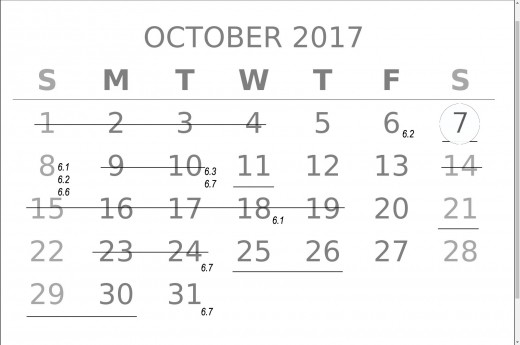

© 2017 Joseph Ritrovato






